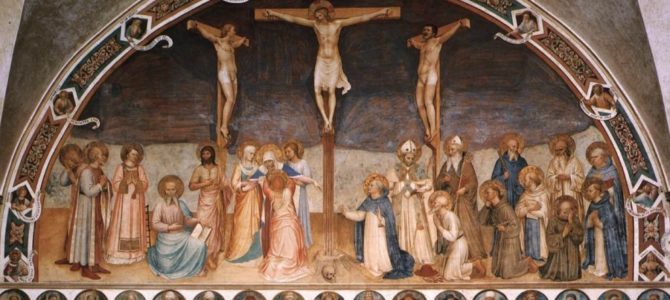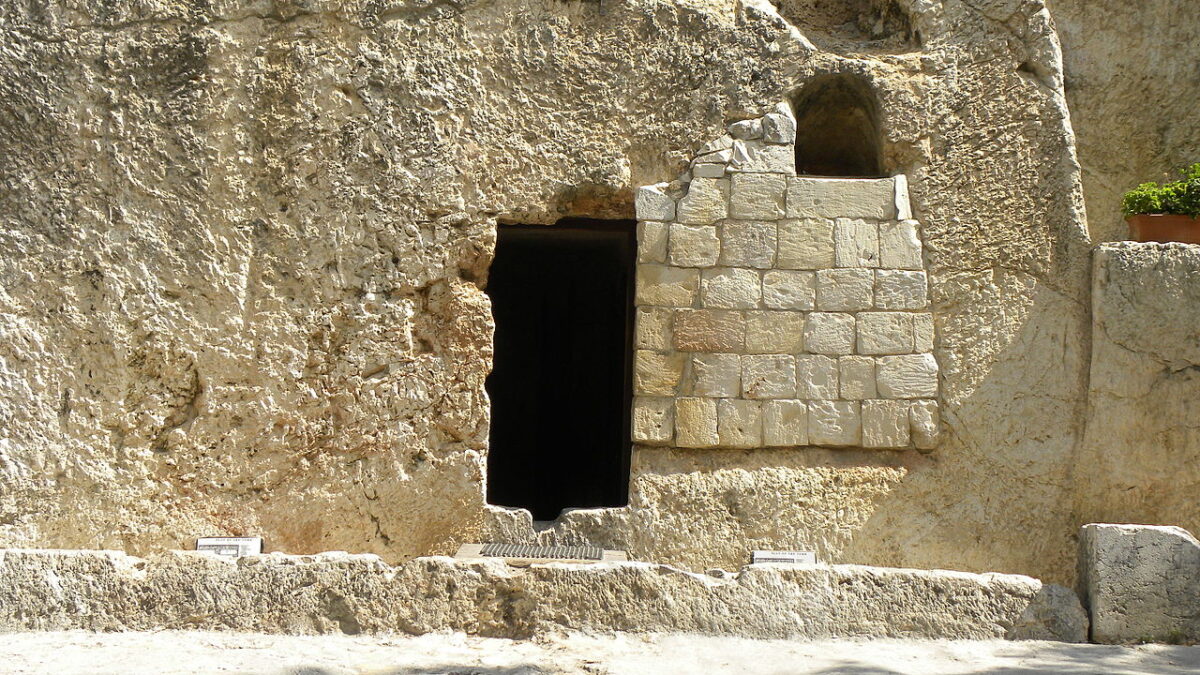
Before Christians joyously celebrate the Resurrection of Jesus Christ on Easter Sunday, they first must make a gruesome stop at a hill called Calvary. Two days before the trumpets sound, and churches—many opening for the first time in a year—fill their sanctuaries with lilies, dogwood, and alleluias, we first must witness the hideous trial of the sinless Lord, the bloody brutal scourging by Roman soldiers and his anguishing suffering and suffocating death on the cross, a day called “Good Friday.”

The origin of the name “good” for such a grim and grisly day is unknown, but the earliest use of “guode Friday” is in a text from around 1290, according to the Oxford English dictionary. Some say it comes from the use of “good” as an adjective, an Old English synonym for “holy,” while other sources see its origins in the term “God’s Friday,” or Gottes Freitag, or Gute Freitag.
The Baltimore Catechism, the standard U.S. Catholic school text from 1885 to the 1960s, calls Good Friday good because of its salvific nature: Christ “showed His great love for man and purchased for him every blessing.”
Good Friday—a holiday in just 10 states—is celebrated by most Christian denominations, with fasting and somber worship services that often end in silence. The liturgy of Good Friday generally consists of the reading of the Passion narrative and in some churches, adoration of the cross. Many Catholic churches follow the Stations of the Cross, a 14-station devotion that commemorates Jesus Christ’s last day on Earth as a man.
Dating to the ninth century, Tenebrae is one of the oldest traditions in the Christian church for the commemoration of the passion and death of Christ. From Latin, Tenebrae can be translated as “shadows,” “darkness,” “death,” or “night.”
Through scripture readings and hymns, the story of Christ’s betrayal, trial, and crucifixion is told. As the Passion story unfolds, candles are extinguished, until the death of Christ, when only one light is left burning. This light is removed from the sanctuary, symbolizing Christ’s death and entombment.

In the 17th century, a three-hour service, a meditation on Jesus’ “Seven Last Words on the Cross,” was introduced into the Catholic liturgy, and is celebrated today across Christian traditions and in Eastern Orthodox churches. According to the Gospels, Jesus was tried before the Jewish and Roman courts at daybreak, then led to Golgotha, where He was nailed to the cross at the third hour (9 a.m.). At noon, darkness covered the earth for three hours, and Jesus died at the ninth hour (3 p.m.)
The seven last words of Christ are recorded in the four Gospels. Of those standing mocking and cursing him, He said, “Father, forgive them, for they do not know what they are doing” (Luke 23:34). To the confessing criminal on the cross next to him, He said, “I tell you the truth, today you will be with me in paradise” (Luke 23:43).
To his mother Mary and disciple John standing at the foot of the cross, He said, “Dear woman, here is your son,” and to the disciple, “Here is your mother” (John 19:26-27). To his Father, using the words of Psalm 22, He said, “Eli, Eli, lama sabachthani?”—that is, “My God, My God, why have You forsaken Me?” (Matthew 27:46, Mark 15:34).
In those last seven words, He also said, “I am thirsty” (John 19:28); “It is finished” (John 19:30); and finally, Jesus called out with a loud voice, “Father, into your hands I commit my spirit.” When He had said this, He breathed his last (Luke 23:46).
An earthquake hit, tombs broke open, and the Temple curtain around the holy of holies tore through. The centurion on guard at the cross declared, “Truly this was God’s Son!” (Matthew 27:45-54). Jesus’s body was removed from the cross and laid in a tomb.
On Good Friday, we also read of the disciples who followed Jesus from Galilee to Jerusalem and then to Calvary, who witnessed his suffering and heard his last words. Matthew writes that “many women” were at the foot of the cross. He names Mary Magdalene, Mary the mother of James and Joseph, and the mother of the sons of Zebedee (Matthew 27:55–56). Mark adds Salome to the list (Mark 15:40), and John mentions Mary, his mother, and his mother’s sister, Mary the wife of Clopas, as well as Mary Magdalene (John 19:25).
John was the only male disciple mentioned who was at the crucifixion. Judas had betrayed him, Peter had denied him. The others had fled.

Recognizing the grievous agony of the crucifixion, hymnwriters through the ages have found words and music to express the sorrow of sin-sick souls for whom Christ suffered and died. In worship, and at home, these hymns offer opportunities for quiet meditation and prayer.
“O sacred Head, now wounded, with grief and shame weighed down, now scornfully surrounded with thorns, thine only crown!” “O Sacred Head Now Wounded” is attributed to St. Bernard of Clairvaux (1153), translated into German by Paul Gerhardt, 1607-1676, a great hymnist of the church, with harmony by Johann Sebastian Bach.
“Tell me, ye who hear him groaning, was there ever grief like his? Many hands were raised to wound him, none would interpose to save; but the deepest stroke that pierced him was the stroke that Justice gave.” “Stricken, Smitten and Afflicted” was written by Irish pastor Thomas Kelly, 1769-1855, who studied law before entering the ministry.
“I am so wondrously saved from sin, Jesus so sweetly abides within; There at the cross where he took me in.” “Down at the Cross, also known as “Glory to His Name,” is one of more than 2,000 gospel songs written by American Elisha Hoffman, (1839-1929), who also wrote, “Leaning on the Everlasting Arms.”
“There my burdened soul found liberty.” William Newell (1868-1956) taught at Moody Bible Institute in Chicago. On his way to class, the words for “At Calvary” came to him and he quickly wrote them down.
“On a hill far away stood an old rugged cross, the emblem of suffering and shame… I will cling to the old rugged cross, and exchange it someday for a crown.” An old favorite written by Rev. George Bennard (1873-1958) of Ohio, who worked for years at the Salvation Army, is “The Old Rugged Cross.”
“Upon the cross of Jesus mine eye at times can see the very dying form of One who suffered there for me.” “Beneath The Cross of Jesus” was written by Elizabeth Cecilia Clephane (1830-1869), the daughter of a sheriff in Scotland.
“See, from his head, his hands, his feet, sorrow and love flow mingled down.” The well-known writer Isaac Watts 1674-1748 of England, called “the greatest name among hymnwriters,” wrote “When I Survey the Wondrous Cross,” with music by the well-known composer Lowell Mason (1792-1872) of Massachusetts.
Finally, the haunting melody of this African-American spiritual “Were You There” invites us to reflect on the agony of Christ’s cruel suffering and death as if we were standing at Golgotha. “Were you There when they crucified my Lord… Sometimes It causes me to Tremble, tremble, tremble.”
The cross is foundation of the Christian faith: Good Friday marks the day when wrath and mercy met at the cross. That’s why Good Friday is dark and good.
At the cross, law and gospel converge: Jesus’ sacrifice for our sin and God’s forgiveness in His blood. All redeemed, reconciled, and revealed in three days.









